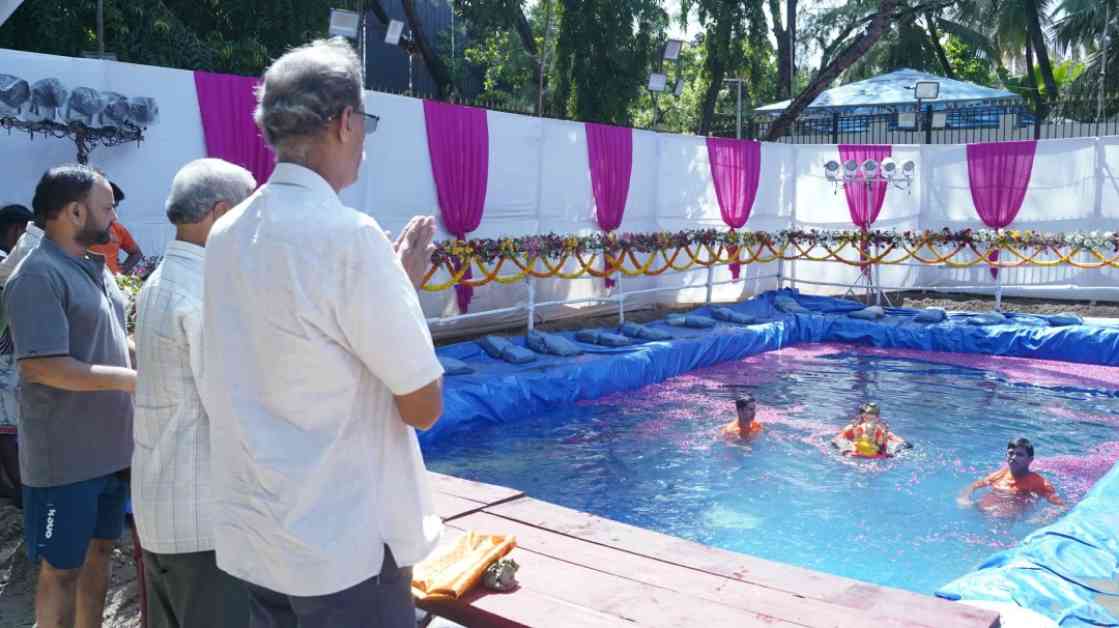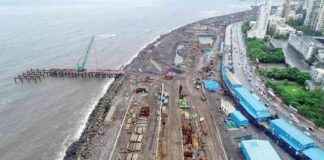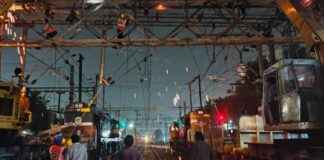Ganeshotsav, also known as Ganesh Chaturthi, is a popular Hindu festival celebrated with much fervor and enthusiasm in Mumbai, India. It marks the birth of Lord Ganesha, the elephant-headed deity, who is considered the remover of obstacles and the god of wisdom and prosperity. One of the key rituals of the festival is the immersion of Ganesh idols in water bodies, symbolizing the departure of the deity to his abode in Mount Kailash.
This year, the Brihanmumbai Municipal Corporation (BMC) reported a significant increase in the number of idols being immersed in artificial ponds during the “1.5-day Visarjan” in Mumbai. According to data released by the BMC, a total of 62,569 idols were immersed until midnight on Sunday, September 8. Out of these, 30,177 idols were immersed in manmade ponds, marking a 7% increase from the previous year.
The data revealed that 62,197 of the idols immersed were household idols, 348 were community idols, and 24 were Hartalika idols. Interestingly, nearly 98% of the idols submerged in artificial ponds came from households. There was also a noticeable 20% rise in the immersion of community idols, indicating a shift towards collective participation in the festival.
Despite the increase in the immersion of idols in artificial ponds, the overall number of idol immersions in Mumbai has seen a decline compared to the previous year. Reports suggest that this could be attributed to a growing preference for metal idols or the practice of immersing idols at home instead of in public water bodies. Last year, a total of 65,684 idols were immersed after one and a half days in Mumbai, with 27,290 idols (41.5%) being submerged in manmade ponds.
In contrast to Mumbai, the Panvel Municipal Corporation witnessed a lower percentage of idols being immersed in artificial lakes, with only 14% of the total idols being submerged in manmade ponds. A total of 8,624 idol immersions took place in Panvel, with 1,222 occurring in artificial lakes organized by the municipal corporation.
During the 10-day festival, idols are traditionally immersed after 1.5, 5, 7, or 10 days, depending on the customs followed by different households and communities. To facilitate the immersion process, the BMC constructed 204 artificial ponds this year, representing a 7% increase from the 191 ponds built in 2023. These artificial ponds are constructed using inflatable tubes filled with water, providing a temporary water body for the immersion of idols.
In a bid to innovate and improve the efficiency of the immersion process, the BMC introduced a new type of pond that does not require digging. Instead, these ponds utilize aluminium sheets and plastic liners to make them waterproof, reducing the cost of construction significantly. This new technique has made it more affordable to create artificial ponds, enabling the BMC to set up these ponds in public parks and residential areas across the city.
The use of artificial ponds for idol immersion serves multiple purposes. It helps in conserving natural water bodies, preventing pollution caused by toxic materials used in making idols, and ensuring the safety of aquatic life. By encouraging the use of manmade ponds, the BMC aims to promote eco-friendly practices during the festival and reduce the environmental impact of the celebrations.
The Significance of Ganesh Chaturthi
Ganesh Chaturthi holds immense cultural and religious significance for the people of Maharashtra and other regions where the festival is celebrated with great zeal. The festival typically lasts for 10 days, with elaborate rituals and festivities taking place throughout the period. It is believed that Lord Ganesha visits the homes of his devotees during this time, bringing blessings and prosperity to their households.
The installation of Ganesh idols in homes and pandals (temporary structures for worship) is a common practice during Ganesh Chaturthi. Devotees offer prayers, perform aarti (rituals involving light) and bhajans (devotional songs), and partake in communal feasting as part of the celebrations. On the final day of the festival, known as Anant Chaturdashi, the idols are immersed in water bodies, symbolizing the departure of Lord Ganesha.
The immersion process, also known as Visarjan, is a poignant moment for devotees as they bid farewell to the beloved deity. The sight of colorful processions, beating drums, and chanting of hymns fills the air as the idols are carried to the water bodies for immersion. The act of immersion is seen as a way to seek the blessings of Lord Ganesha for the coming year and to express gratitude for his presence during the festival.
Promoting Eco-Friendly Practices
In recent years, there has been a growing awareness about the environmental impact of Ganesh Chaturthi celebrations, particularly the pollution caused by the immersion of idols in natural water bodies. Many idols are made from non-biodegradable materials such as plaster of Paris, chemical paints, and other harmful substances, which can contaminate water sources and harm aquatic life.
To address these concerns, the BMC has been actively promoting eco-friendly practices during Ganeshotsav, encouraging devotees to opt for clay idols and immerse them in artificial ponds. Clay idols are biodegradable and do not pose a threat to the environment, making them a sustainable choice for the festival. By using artificial ponds for immersion, the BMC aims to minimize the ecological impact of the festival and protect the city’s water resources.
The shift towards eco-friendly practices has been well-received by the public, with many households and communities embracing the use of clay idols and participating in the immersion process in artificial ponds. The increasing number of idols being immersed in manmade water bodies reflects a positive trend towards environmental consciousness and sustainable living among the citizens of Mumbai.
Innovations in Immersion Process
The introduction of new techniques and technologies for creating artificial ponds has further enhanced the immersion process during Ganesh Chaturthi. The use of inflatable tubes, aluminium sheets, and plastic liners has made it easier and more cost-effective to set up temporary water bodies for idol immersion. These innovative methods have not only reduced the environmental impact of the festival but also improved the efficiency of the immersion process.
By eliminating the need for digging and using waterproof materials, the new type of ponds established by the BMC offer a practical solution for facilitating idol immersion in a sustainable manner. The ponds are strategically located in public spaces and residential areas, making it convenient for devotees to participate in the Visarjan ceremony without harming the environment.
Overall, the increase in the immersion of idols in artificial ponds in Mumbai and Panvel signifies a positive shift towards eco-conscious practices during Ganeshotsav. By embracing sustainable alternatives such as clay idols and manmade water bodies, devotees are contributing to the preservation of the environment and the promotion of a greener future for generations to come. As the tradition of Ganesh Chaturthi continues to evolve, it is heartening to see the community coming together to celebrate the festival in a responsible and environmentally friendly manner.




















